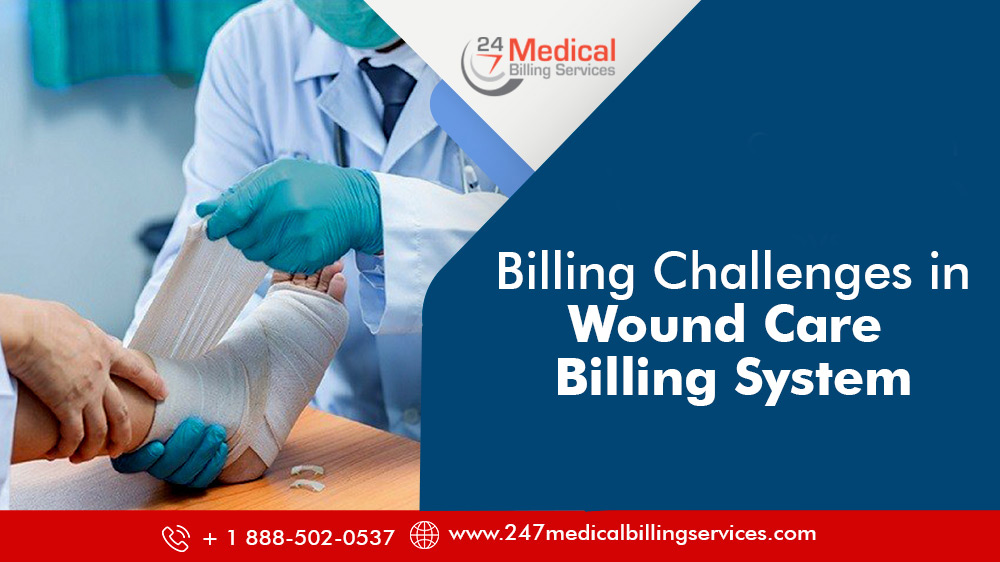
Billing Challenges in Wound Care Billing System
Most medical centers provide excellent wound care services to patients, but they face a lot of issues with wound care billing system. Most physicians and hospitals don't have a proper billing system in place, and hence they are losing a significant amount of revenue. Nowadays, it is vital to understand the challenges in the medical billing system for wound care and seek out solutions for the same.
Wound Care Management, billing and coding procedure that requires the in-house accounts department to be constantly on their toes. From coding and billing, instalment/payment for wound care administrations is an incredible challenge in numerous facilities. The most essential function of which is to tackle the denials proving to be a hindrance to a clinic's bottom line. Avoiding confusion is critical, particularly for wound care management. From a billing and coding perspective, wound care includes the evaluation of services and the management of denials and denial compliance.
In this article, we are going to discuss the most common challenges around wound care medical billing:
- The coverage verification
Most of the wound patients physicians and hospitals receive are through referral. The physician and hospitals have to verify if their insurance covers the services provided. You cannot assume anything related to insurance. Every time a patient comes, you will have to verify the insurance coverage, which becomes a time-consuming process and requires dedicated staff.
- Maintaining the records
Unlike some other care services, the wound supplies include expensive products and your billing team has to be experienced enough to ensure everything is properly coded and billed so there is no loss in revenue due to claim denials and rejections. In most cases, the billing team is not experienced, or they don't have the latest software to maintain the records for easy claims.
- Clarity in terms of what constitutes a wound
There have been disagreements, and debates about what constitutes a wound versus an ulcer. It is imperative that you are aware of ICD-10 semantics, as many clinicians may interchange the terms “ulcer” and “wound” as if they are interchangeable, which they are not when it comes to ICD-10 coding.
- RAC auditors
Auditing is very common in the medical billing industry. RAC auditors have already kept wound care very high on their priority list. If you are new to the industry, you will get the impression, RAC wants to give back all the money disbursed to centers. You will have to ensure the paperwork submitted to them for auditing is 100% crystal clear and everything is in order as per their liking. Maintaining such detailed and ordered record is a big challenge for wound care billing.
- ICD-10-PCS
ICD-10-PCS distinguishes between excisional and non-excisional debridement. The ICD-10-PCS root operations excision and extraction denote excisional debridement and non-excisional debridement, respectively. It is not necessary for physicians to use the term extraction, though, if documentation shows the tissue was removed or stripped, it is an extraction and not a cut. ICD-10 will require coders to capture laterality and more specific anatomic wound locations.
- Too much technicality to know
The billing team has to know different types of wound cares that come in and actions they need to perform related to each wound. For example, they will have to understand the difference between open fracture debridement, wound debridement, and active wound care coding. Subject matter experts better manage such things, and your billing team may find it hard to deal with different types of cases.
Conclusion
There are too many areas to handle with wound care billing system. Setting up a team that can manage all areas efficiently is difficult for physicians and hospitals. They can either look to outsource their work or set up an efficient team since any mistakes by the billing team, can result in a loss of revenue. The billing of wound care billing services usually involves a thorough evaluation of the patient’s medical record for the wound, including wound dimensions, chronic diseases which includes diabetes, chronic ulcers, quadriplegia, etc. procedures offered to manage the wound, follow-up, first visit, photographs of the wound, and wound progress. With 24/7 Medical Billing Services, all the above mentioned points will be handled carefully.
Read More: Simplifying The Task Of Wound Care Billing With The Help Of Advanced Systems

.png)